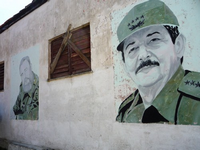As if absurdity weren't already the norm in U.S.-Cuba relations, three years ago the U.S. Interest Section, housed in a rectangular seven-story building in the Vedado district of Havana, began broadcasting a news ticker across its sixth-floor windows. The five-foot, red-orange lettering crept from one end of the building to the other, like anachronistic soldiers leftover from an ideological war settled long ago.
Unfortunately, however, nobody seems to have told either the Americans or the Cubans. In kind, Fidel Castro ordered a million people to march on the building in protest. The Cuban government proceeded to block the ticker's view with billboards in a -- let's be frank here -- childish, tit-for-tat battle. The story only underscored what has become a ludicrous diplomatic debacle between the two countries separated by barely 90 miles.
In July, the Obama administration thankfully turned off the ticker. But during his campaign for the White House, President Barack Obama pledged to ease travel restrictions to Cuba, and upon his election many were hoping that he would go even further. Over the course of four decades, by laws, decrees, and other methods that rely on legislation dating back to the Trading With the Enemy Act of 1917, the U.S. has erected an intricate tangle of restrictions that have constituted a wholesale embargo on the island. The hope, of course, was that Obama would lift the embargo, and in turn, open a new chapter of U.S. foreign relations with not only Cuba, but all of Latin America.

